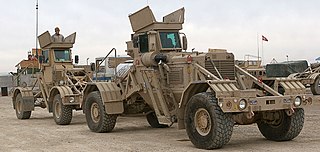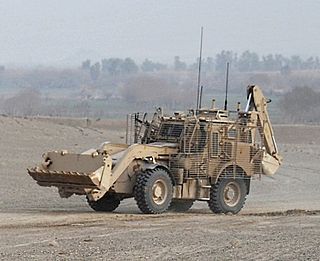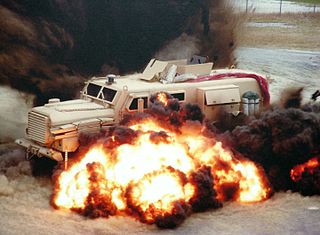 W
WA military engineering vehicle is a vehicle built for the construction work or for the transportation of combat engineers on the battlefield. These vehicles may be modified civilian equipment or purpose-built military vehicles. The first appearance of such vehicles coincided with the appearance of the first tanks, these vehicles were modified Mark V tanks for bridging and mine clearance. Modern military engineering vehicles are expected to fulfil numerous roles, as such they undertake numerous forms, examples of roles include; bulldozers, cranes, graders, excavators, dump trucks, breaching vehicles, bridging vehicles, military ferries, amphibious crossing vehicles, and Combat engineer section carriers.
 W
WThe armored bulldozer is a basic tool of combat engineering. These combat engineering vehicles combine the earth moving capabilities of the bulldozer with armor which protects the vehicle and its operator in or near combat. Most are civilian bulldozers modified by addition of vehicle armor/military equipment, but some are tanks stripped of armament and fitted with a dozer blade. Some tanks have bulldozer blades while retaining their armament, but this does not make them armored bulldozers as such, because combat remains the primary role — earth moving is a secondary task.
 W
WThe Armoured Engineer Reconnaissance Vehicle (AERV) is an Indian military engineering vehicle developed by Vehicle Research and Development Establishment, Ahmednagar jointly with Research and Development Establishment, Pune, in coordination with C-TEC, as per the QRs of the Indian Army for enabling the combat engineers to conduct recce operations. It is manufactured by Ordnance Factory Medak. The AERV is based on Sarath's hull and is designed to carry out terrestrial and riverbed survey to facilitate construction of assault bridges across water obstacles in both offensive and defensive operations in plains, desert and riverine terrain. It has no gun and is fitted with specialised equipment, including an echo-sounder, a water current meter, a laser range finder and GPS. On the left rear of the hull, a marking system with 40 rods is fitted. The AERVs have achieved limited series production and have entered service with the Corps of Engineers.
 W
WKunduz or AZMİM, is a Turkish tracked amphibious combat engineering armoured bulldozer.
 W
WThe T-64 is a Soviet second-generation main battle tank introduced in the early 1960s. It was a more advanced counterpart to the T-62: the T-64 served in tank divisions, while the T-62 supported infantry in motorized rifle divisions. It introduced a number of advanced features including composite armor, a compact engine and transmission, and a smoothbore 125-mm gun equipped with an autoloader to allow the crew to be reduced to three so the tank could be smaller and lighter. In spite of being armed and armored like a heavy tank, the T-64 weighed only 38 tonnes.
 W
WThe T-54/T-55 tank series is the most widely used tank in the world and has seen service in over 50 countries. It has also served as the platform for a wide variety of specialty armored vehicles.
 W
WThe T-54/T-55 tank series is the most widely used tank in the world and has seen service in over 50 countries. It has also served as the platform for a wide variety of specialty armored vehicles.
 W
WHobart's Funnies is the nickname given to a number of specialist armoured fighting vehicles derived from tanks operated during the Second World War by units of the 79th Armoured Division of the British Army or by specialists from the Royal Engineers.
 W
WC7P was a Polish tracked artillery tractor, used by the Polish Army before and during World War II. The tractor was developed by the design bureau of Witold Jakusz of the PZInż company between 1931 and 1934.
 W
WThe Centurion was the primary British army main battle tank of the post-Second World War period. Introduced in 1945, it is widely considered to be one of the most successful post-war tank designs, remaining in production into the 1960s, and seeing combat in the front lines into the 1980s. The chassis was also adapted for several other roles, and these have remained in service to this day.
 W
WThe Cheetah MMPV was a prototype built by the Force Protection, Inc., division of General Dynamics. It was intended as part of Force Protection's armoured military vehicle line-up, which includes the MRAP-class of Buffalo and Cougar vehicles and the Ocelot light protected patrol vehicle (LPPV).
 W
WThe Tank, Infantry, Mk IV (A22) Churchill was a British heavy infantry tank used in the Second World War, best known for its heavy armour, large longitudinal chassis with all-around tracks with multiple bogies, its ability to climb steep slopes, and its use as the basis of many specialist vehicles. It was one of the heaviest Allied tanks of the war.
 W
WHobart's Funnies is the nickname given to a number of specialist armoured fighting vehicles derived from tanks operated during the Second World War by units of the 79th Armoured Division of the British Army or by specialists from the Royal Engineers.
 W
WHobart's Funnies is the nickname given to a number of specialist armoured fighting vehicles derived from tanks operated during the Second World War by units of the 79th Armoured Division of the British Army or by specialists from the Royal Engineers.
 W
WThe Caterpillar D9 is a large track-type tractor designed and manufactured by Caterpillar Inc. It is usually sold as a bulldozer equipped with a detachable large blade and a rear ripper attachment.
 W
WThe Israeli Armored CAT D9—nicknamed Doobi —is a Caterpillar D9 armored bulldozer that was modified by the Israel Defense Forces, Israeli Military Industries and Israel Aerospace Industries to increase the survivability of the bulldozer in hostile environments and enable it to withstand heavy attacks, thus making it suitable for military combat engineering use. The IDF Caterpillar D9 is operated by the Israel Defense Forces (IDF) Combat Engineering Corps for combat engineering and counter-terrorism operations.
 W
WThe Engin Blindé du Génie is a military engineering vehicle built upon the chassis of the AMX-30 battle tank.
 W
WThe Fahd is a 4x4 Egyptian armored personnel carrier, designed to fit the requirements of the Egyptian Military. It replaced older APCs in Egyptian service such as the BTR-40, and the Walid. It has been used by eight nations including Egypt, besides being used by the United Nations.
 W
WThe Centurion was the primary British army main battle tank of the post-Second World War period. Introduced in 1945, it is widely considered to be one of the most successful post-war tank designs, remaining in production into the 1960s, and seeing combat in the front lines into the 1980s. The chassis was also adapted for several other roles, and these have remained in service to this day.
 W
WThe Husky VMMD is a South African configurable counter-IED MRAP designed for route clearance and demining. It is designed to assist in the disposal of land mines and improvised explosive devices.
 W
WThe T-54/T-55 tank series is the most widely used tank in the world and has seen service in over 50 countries. It has also served as the platform for a wide variety of specialty armored vehicles.
 W
WThe JCB HMEE is a military vehicle made by JCB.
 W
WKamaz Typhoon is a family of Russian multi-functional, modular, armoured, mine resistant MRAP vehicles manufactured by the Russian truck builder Kamaz. The Typhoon family is part of Russia's Typhoon program. As of May 2020, the number of Typhoons in the Russian Armed Forces fleet is more than 310 units of Typhoon-K.
 W
WThe M3 Amphibious Rig is a self-propelled, amphibious bridging vehicle that is used for the projection of tanks and other vehicles across water obstacles.
 W
WMine-Resistant Ambush Protected is a term for United States military light tactical vehicles produced as part of the MRAP program that are designed specifically to withstand improvised explosive device (IED) attacks and ambushes. The United States Department of Defense MRAP program began in 2007 as a response to the increased threat of IEDs during the Iraq War. From 2007 until 2012, the MRAP program deployed more than 12,000 vehicles in the Iraq War and War in Afghanistan.
 W
WThe T-54/T-55 tank series is the most widely used tank in the world and has seen service in over 50 countries. It has also served as the platform for a wide variety of specialty armored vehicles.
 W
WThe Pookie MRAP vehicle was created to deal with the constant mining of the roadways during the Rhodesian Bush War.
 W
WThe Puma is a heavily armored Combat engineering vehicle and armored personnel carrier that the Engineering Corps of the Israeli Defence Forces has used since the early 1990s. The vehicle can carry a crew of up to eight. The 50-ton vehicle's speed is 45 kilometers an hour.
 W
WThe Sisu RA-140 DS "Raisu" is a flail-type demining vehicle developed and produced by the Finnish company Sisu-Auto and later produced by Patria Vehicles in the years 1994–2001. The production totalled 41 units.
 W
WThe Sōkō Sagyō Ki , also known as the SS-Ki (SS機/SS器), was a fulltrack engineering vehicle of the Imperial Japanese Army (IJA) introduced in 1931. The vehicle was considered by the IJA to be one of its most versatile multi-function support vehicles.
 W
WThe T-54/T-55 tank series is the most widely used tank in the world and has seen service in over 50 countries. It has also served as the platform for a wide variety of specialty armored vehicles.
 W
WTyphoon is a Russian family of Mine-Resistant Ambush Protected (MRAP) armored vehicles in service since 2014. Around 120 Russian companies including KamAZ, Gaz-Group, and Bauman University, etc. are taking part in Typhoon program. The main aim of the program is to design a fundamentally new unified platform for all Russian armored wheeled vehicles.
 W
WVIU-55 Munja is a combat engineering vehicle produced by Serbia. VTI has done the conceptual design of the Munja general-purpose engineer vehicle and the Čačak-based Overhaul Depot has built the vehicle. The main idea was converting the T-55 tank, using its main structure and subsystems and adding new components, equipment and devices to create a vehicle for entirely different purposes. Good terrain negotiating ability and ballistic protection of T-55 tank were retained, while engineer equipment and armament were refitted. It is the first armoured vehicle for the engineer corps outfitted with special purpose engineer equipment and respectable armament, belonging to the most modern designs of this kind.